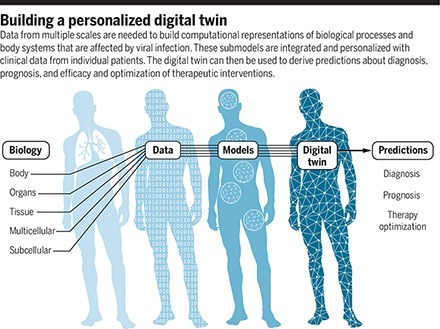No current tool can predict the course of disease and help a doctor decide on the most appropriate treatment for an individual COVID-19 patient.
Digital twins are software replicas of the dynamic function and failure of engineered products and processes. The medical analog, patient-specific digital twins, could integrate known human physiology and immunology with real-time patient-specific clinical data to produce predictive computer simulations of viral infection and immune response. Such medical digital twins could be a powerful addition to our arsenal of tools to fight future pandemics, combining mechanistic knowledge, observational data, medical histories, and the power of artificial intelligence (AI).
Although medical digital twins are much more difficult to develop than those for engineered devices, they have begun to find applications in improving human health.
Examples include the “artificial pancreas” for type 1 diabetes patients
Building a personalized digital twin
Data from multiple scales are needed to build computational representations of biological processes and body systems that are affected by viral infection. These submodels are integrated and personalized with clinical data from individual patients. The digital twin can then be used to derive predictions about diagnosis, prognosis, and efficacy and optimization of therapeutic interventions.
Digital twins describing infection and treatment require the development, validation, and integration of numerous component submodels in the context of a rapidly developing scientific understanding of biological behaviors and continual generation of new experimental and clinical data.
Although individual laboratories may construct submodels, the development of comprehensive digital twins will require laboratories and research groups around the world to integrate and validate submodels independently, with only limited central coordination.
Enabling such parallel development requires a flexible simulation architecture that uses a multiscale map of all the relevant components of a patient's response to viral infection, as well as responses to available treatments.
read the paper at https://science.sciencemag.org/content/371/6534/1105.full



 Your new post is loading...
Your new post is loading...







